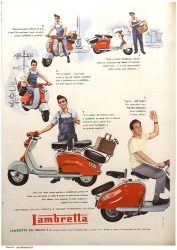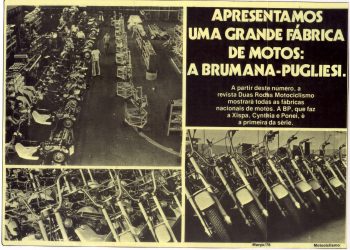Like Argentina and Colombia, Brazil was also part of the “Big Lambrettisti Homeland,” as the Lambretta managed to establish itself in Brazilian society and culture in the mid-20th century. Today, with the guidance of Valmir Claudino Dos Santos -an expert in the field- we will dive into this rich history and its fascinating historical aspects. Enjoy it!
The Customer’s Dream (the 50’s and 60’s)
 |
| Lambretta Factory |
In 1955, under license of Innocenti, Lambretta’s started being manufactured in Brazil by the company “Lambretta do Brasil S/A – Indústrias Mecânicas“, owned by businessman Paulo Pascowitch. This company, located in the Lapa neighborhood in São Paulo, was one of the first scooter factories to be established in Brazil.
The first models produced were the Lambretta D and LD 150. With the deployment of a network of resellers and authorized service stations in various cities, along with advertising through ads in widely circulated magazines and newspapers, the Lambretta quickly gained popularity on the streets.
In addition to being used as a means of transportation for various activities, the Lambretta was also used in sports such as racetracks races or improvised circuits on city streets, endurance tests, long trips, “gymkhanas” (obstacle races), and leisure competitions. Undoubtedly, the Lambretta became a true craze among the youth of the time.
In 1958, a second version of the LD 150 was introduced, featuring a fairing on the handlebars. Unlike the Italian version, the Brazilian version had the speedometer mounted in a glove compartment installed at the rear of the front shield, rather than on the handlebars.
To get an idea of the impact the Lambretta had in Brazil, edition 455 (January 7th 1961) of the magazine “Manchete” (a successful publication of the time) welcomed the new year by showcasing the products that were part of the modern wonders that consumers dreamed of. The Lambretta was one of the featured items, along with the television, air conditioning unit, refrigerator, and portable battery-operated radio.
In 1961, the D and LD models were replaced by the LI 150, derived from the Italian LI 150 Series 2. The first units for sale were imported from Italy, but they soon started being manufactured in Brazil, bearing the emblem “Lambretta série Brasil“ on the front shield. At the same time, the “Moto Furgão Lambretta 175cc” model, derived from the Italian utility model “Lambro”, also began the manufacturing process.
Advertisements of “Lambretta do Brasil,” published in magazines and newspapers, highlighted the innovations and qualities of the new model. Dealership ads not only showcased the features and advantages of the LI 150 but also offered various financing plans, took in trade the customer’s old Lambrettas, and even provided a free training course and driver’s license.
In December 1961, the Lambretta LI 150 was exhibited at the 2nd Automobile Expo, an event attended by political figures of the time, including the governor of São Paulo, Carvalho Pinto, and Prime Minister Tancredo Neves.
Around the same time, a version with a more powerful engine, called the Lambretta X-175 (sister to the Italian TV175 Series 2 model), joined the LI 150. Both models were manufactured until 1971 and became the most successful ones in Brazil.
During the 60’s, “Lambretta do Brasil S/A – Indústrias Mecânicas“ changed its name to “Compañia Industrial Pasco Lambretta“. The term “Pasco” derived from the factory owner’s last name, Pascowitch, and it is the origin of the expression “Lambretta Pasco“.
In January 1966, a commemorative advertisement, marking the 11th year of activity for “Cia. Industrial Pasco Lambretta“, the Lambretta line was highlighted, accompanied by the new Pasco MT-9 micro tractor (designed for agricultural work) and the launch of an engine for nautical use.
To enable ownership of a Lambretta, there were various financing plans and simplified sale terms offered by authorized dealers and resellers. A plan named “Campanha popular da Lambretta” was also available, a special financing plan promoted by “Caixa Econômica Federal“, which was (and still is) the main public financial institution in Brazil.
Those who couldn’t afford a Lambretta could be lucky enough to win one. Lambretta’s were one of the prominent prizes in lotteries, raffles, draws, promotions by commercial establishments, and soft drink brands. There even existed a sticker album in which when completed, it formed an illustration of a Lambretta; once fulfilled, it entitled you to a Lambretta as a prize!
Lambretta’s success and popularity during the 50’s and 60’s were so great that the word “lambreta“ – written with a lowercase “l” and a single “t” – became the local slang when referring to a scooter.
The decadence (the 70’s)
In 1971, the LI 150 and X-175 models were replaced by the S150 and S175 (corresponding to the Italian “Special” model). Later, these models were called “Cynthia“. At the same time, a new version with a slightly different design, called the “MS” (short for “Mini Skirt”), was produced, featuring a narrower front shield and platform, cutouts in the side panels, side fixed footrests replaced by retractable ones, and a different type of exhaust system.
In the 70’s, Japanese motorcycles started to dominate the two-wheeler market in Brazil, and the Lambretta was not as desired as it was previously. It was here when Pasco began manufacturing the “Xispa“ model, which used the same engine as the Lambretta but mounted on a motorcycle chassis. The “Xispa SL“ model (150 cc and 175 cc) had a foot-operated gear shift lever, and the “Xispa TS model“ (150 cc and 175 cc) had a gear shift lever on the left handlebar, similar to Lambretta.
In 1974, businessmen Oliviero Brumana and Felipe Pugliese acquired share control of Pasco, and the company was renamed to “Brumana Pugliese S.A. Industria e Comércio de Motores e Veículos“, relocating its factory to new facilities in Jardim Santo Elias, very close to the original Pasco factory in São Paulo.
During the 70’s, the model lineup diversified with the adding of the utilitarian Lambretta Cynthia (a three-wheeler model equipped with frame to hold an enclosure that served very well for deliveries), the Lambretta “Xispa Motokarga“ (a utility tricycle version of the Xispa), the “Tork“ model, the “Lambretta BR“ and a small Minarelli-powered moped called the “Ponei“. Later, the Xispa model was discontinued in favor of the Tork and BR Lambretta models.
The “Brumana Pugliese S.A” company ended its operations in 1982.
During the 80’s and 90’s, similar to what occurred in Argentina, the majority of Lambrettas were forgotten in yards or discarded in landfills. An old Lambretta at the time could have a price compared to that of a bicycle. The few units that were still in service on the streets of Brazil were in very poor and mistreated conditions.
Starting in the year 2000, a revaluation process started and many units began to be seen on the streets, impeccably restored, colorful and shiny as when they left the factory decades ago. They went from being undesirable junk, to being the object of desire: those who have a Lambretta do not get rid of it; those who don’t, dream of having one.
The influence of Lambretta in Brazilian football
The rainbow flick (“arcoiris” in Spanish or “carretilhas” in Portuguese), which consists in a self pass over the adversary’s head, shot by the player’s feet from it’s back, is known as the “lambreta” in the Brazilian football’s culture. This flick was made very popular by Neymar Jr. Although it’s not clear which is the relation between this flick and the scooter brand, it’s very interesting to appreciate that it’s referenced as “lambreta”, as they popularly called the brazilian made scooter of the time.
Disclaimer: This article is an edited translation made by El Siambrettista from the original article written, by request of El Siambrettista for being published on our website, by Valmir Claudino Dos Santos. You will find the original article, in Portuguese, in this link.
Additionally, we want to give a BIG THANK YOU to Victor Rodriguez for his support on this article’s translation.
La traducción de esta página no fue realizada por un traductor profesional. Si encontrás errores y queres colaborar con la traducción del sitio, por favor contactate con nosotros
















































